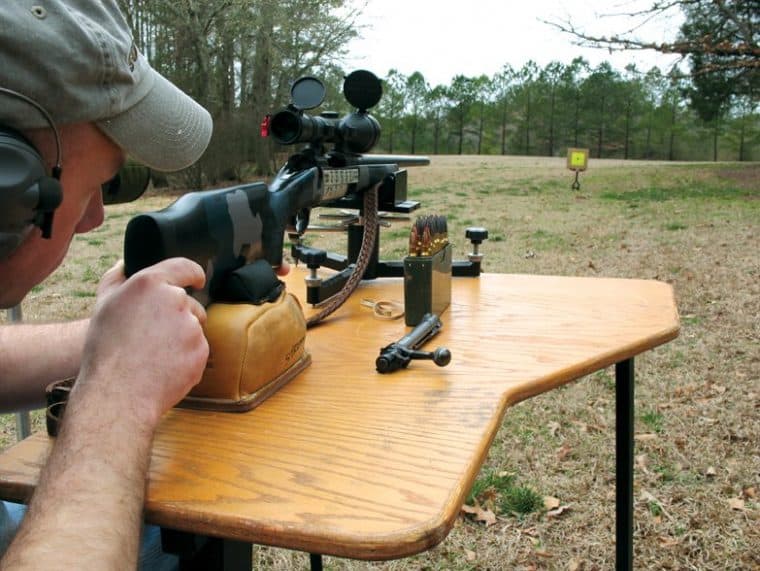For years hunters and competition shooters have been arguing about the most efficient range to sight in a riflescope. More often than not, it is between 100 – 200 yards.
However, have you actually shot a scope that’s been sighted in correctly at those ranges?
The average hunter is firing at a target ~150 yards away, quickly, and sometimes moving. Sighting in at 100 or 200 yards is going to put you inside the bread box, but if the bread box is 6 in. in diameter or smaller; that isn’t going to cut it.
The solution? Learn how to sight your rifle in at a near point blank range. Surprisingly enough, it’s super helpful for getting your scope sighted into longer ranges like 100 yards or further.
So that’s what this post is about, how to sight in a rifle scope at 25 yards.
Tools for the job
Screwdriver – Your riflescope is equipped with Windage and Elevation turrets. It is a capped circle usually with 1 click = 1 MOA written on the inside. The screw is most often a flat-head, but it is a good idea to check before heading out.
Paper Targets – Hopefully you’ve had enough range time to amass a supply of paper targets. The best paper targets are bright white with clear, defined, black grid lines.
Grid spacing should be 1 inch, and the target should be easily visible at 100 yards.
Marker – An actual marker. This is going to be how you keep track of everything on your grid paper.
Ammunition – When I first learned how to sight in my rifle scope, I would just buy an entire pack of ammunition and spend it at the range.
Now, I consider myself proficient enough to get zeroed in with less than 5 shots. It’s always better to have too much and not use it than vice versa.
Safety Gear – I have never been to a range that didn’t require protective equipment. Some ranges sell it there or have “loaners”, but don’t take the chance and get some nasty scratched up safety goggles. We are making our rifle as accurate as possible; we need to see as clearly as possible.
Related: How to Sight in your rifle at 50 yards
How to Sight-in a Riflescope at 25 Yards
Now that you’ve gathered everything and you’ve had enough of shooting only your iron sights, let’s head to the shooting range. I will be going over how I sight-in my rifle scopes to get ready for the hunting season. As easy to understand and follow as possible, however, if you have questions here’s a video that walks you through the entire process.
Step 1 (Safety First): After arriving at the range, but before you think about pointing your gun downrange: put on your protective equipment.
Also, if you’re a beginner shooter or with someone who is it will be wise to learn the rule “Treat. Never. Keep. Keep.”.
Treat every weapon as if it were loaded. Make sure you never aim your rifle barrel at anything you don’t intend to shoot. Keep your finger straight and along the receiver until ready to fire. Keep the weapon on safe until ready to fire.
Step 2 (Hang Targets): Hang your target 25 yards from the firing line. Ensure your field of view is unobstructed and that the target is not tilted. If outdoors and the wind is a major problem use some cardboard and staples to secure your target, or even better wait until it is less windy.
Step 3 (Fire): Aim about one inch higher than the center of the target. This will allow you to have a more accurate shot at the 100+ yard ranges due to the projectile’s ballistic path.
Marksmanship in mind fire 3-5 bullets realigning your aim point after each shot. Take your time, each shot counts and there isn’t room for significant error.
Step 4 (Evaluation): When the range has been cleared grab your marker and retrieve your target. Find the center of your round grouping then count the number of vertical squares to the center, subtract 1 and record that number.
Do the same for the Horizontal squares, however, don’t subtract anything from that value and record.
Step 5 (Make Adjustments): Remove the caps from the Windage and Elevation turrets from your riflescope. At 25 yards your rifle should be 1 click = 1 in. on your paper target.
Starting with Elevation use the screwdriver to adjust turn the knob until it clicks the amount of time you wrote down earlier.
Then do the same for your Windage, but keep in mind that to adjust left you will have to turn to the right and vice versa for your Windage.
Step 6 (Fire, Rinse, and Repeat): Rehang the target and fire 2-3 shots at about an inch above the center again. This time after firing you should notice that your grouping has moved, and if adjusted correctly it should be sitting where you were aiming. However, if it isn’t, repeat the steps in this list, until it is.
You want your rifle and scope to be hitting the bulls eye, not just “close enough”.
Accuracy is important, especially if you are going to be hunting big game animals…
Formulas for Adjustments
Not all scopes have the same adjustment measurement. Some have ¼ inch MOA like described above, while others have 1/8 inch or even ½ inch adjustments. These formulas will make it much easier to zero your rifle in at any range, and eliminate many headaches. If you follow these formulas correctly then you should have no problem zeroing in your rifle scope at any range.
(Distance to target in yards) / (100) = inches per MOA at the distance you are shooting.
(Number of inches of adjustment needed) / (inches per MOA at that distance) = MOA adjustment.
(Number of clicks per 1 MOA on scope) * (MOA adjustment) = adjustment in clicks on your scope.
Related: How To Adjust a Rifle Scope Up and Down
Location, Location, Location
I’ve had the pleasure (or misfortune) of shooting at an indoor range that didn’t have enough lights to fully illuminate it. The experience has taught me that even if everything else is perfect, the range itself can still hold you back. Luckily, sighting in your riflescope at this range can be achieved at most ranges.
Be sure to check that the range you go to can support the range you’re shooting at. As well as, allotting you space to position yourself correctly.
There is no substitution for proper marksmanship, so it’s imperative that you treat each of these shots the same way you would out in the field. Slow is smooth, and smooth is fast.
FAQ
Why should I aim 1 inch above the center of the target? – The projectiles ballistic path is going to rise and drop during flight. Aiming a bit higher will allow your long range shots to be more accurate.
Will sighting at 25 yards give me a 100 yard zero? – This is a common myth around the internet. However no, Sighting in at 25 yards and shooting at 100 yards is going to give you about 2.7 inches of play in your round placement. Which is generally not enough to stop you from hitting the vitals on most big game at 100 yards.
Why a 25 yard zero? – You want to zero your rifle in at 25 yards because it will allow you to have accurate shot placement from point blank to about 300 yards.
It’s also easier to find a range that can accommodate sighting in at 25 yards opposed to 100 yards.
Related: How To Sight In A Red Dot Scope
Conclusion
I hope you learned how to sight your rifle in at short range, and can see the difference it makes. One of the more notable being just how much less you need to guess when firing at longer ranges.
There is no substitute for good marksmanship skills, but having your scope sighted in correctly will help build those skills; enabling you to fire faster and more accurately than ever before.



